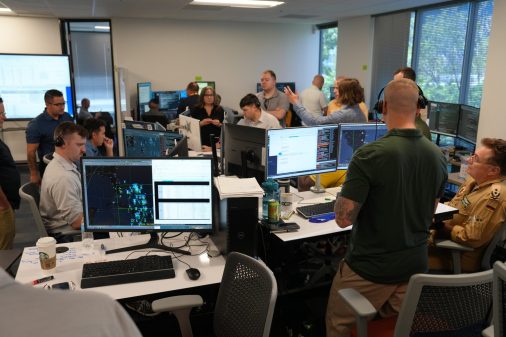Joint Staff pursues ‘major step forward’ to enhance ORION force management platform with AI

The Joint Chiefs of Staff recently moved to modernize its military intelligence platform that supplies high-stakes data analytics, predictive capabilities, and real-time visualization and collaboration tools to decision-makers across the Pentagon’s Joint Planning and Execution Community — with support from BigBear.ai.
In separate discussions on the heels of a $13.2 million sole-source contract award underpinning the work, a Joint Staff spokesperson and two officials from the Virginia-based company briefed DefenseScoop on the near-term plans to enhance the Force Management Directorate (J-35)’s ORION Decision Support Platform, and ultimately offer a more complete, AI-enabled view of the U.S. military’s assets, missions and personnel.
“The DOD operates within a finite force pool, balancing responses to a wide range of global events — from humanitarian assistance to major military operations — often occurring simultaneously. The ORION Decision Support Platform provides a comprehensive view of force capabilities to support real-time decision-making,” a spokesperson from the Joint Staff told DefenseScoop on Tuesday.
Broadly, the J-35 directorate oversees the organizational structure, policies, and resources necessary for the U.S. military branches to collectively maintain readiness and integrate global operations, against a backdrop of complex and evolving threats.
Roots of the hub’s ORION DSP tool stem back more than a decade to the early 2010s.
“Initially, ORION was developed as a prototype to demonstrate the feasibility of a web-based platform that could provide a common operational picture, facilitate collaboration, and support decision-making for joint planning and execution,” the spokesperson noted.
At the time, it was designed to integrate certain data from various DOD sources and produce a comprehensive view of the operational environment.
“The significance of this [latest] news is that it represents a major step forward in the development of a more integrated and collaborative planning capability for the DOD,” the Joint Staff spokesperson told DefenseScoop.
In its current form, the ORION platform consolidates authoritative data from each of the armed services, provides visualization of forces and munitions globally, conducts contingency and crisis analyses, and allows course of action experimentation to inform advice that’s compiled for combatant command planners and other tactical and strategic decision-makers.
“The Joint Staff J-35 ORION is a cloud-based, containerized software suite with web and business intelligence applications. It continues to evolve in line with enterprise [global force management, or GFM] requirements,” said Ryan Legge, BigBear.ai’s president of national security.
Legge noted that BigBear.ai’s history supporting the DOD’s global force management initiative began more than 20 years ago, while its partnership with the J-35 for this effort is about 9 years old.
“The Department of Defense identified the lack of a standardized, integrated system for global force visibility and feasibility assessments and chartered Project ORION. The challenge was managing multiple siloed data sources that required integration to support joint planning and execution,” he told DefenseScoop.
The ORION platform, according to Legge, “is built explicitly for the JPEC” and applies agile methodologies for the continuous integration and delivery of advanced analytics and other software services.
This new contract was awarded via DOD’s Tradewinds Marketplace.
“ORION integrates authoritative data sources identified by the Joint Staff and services, synthesizing information into a holistic global force management perspective. It focuses on warfighting and mission-support capabilities, readiness, availability, and current employment locations — collectively known as ‘CRAE’ data,” the Joint Staff spokesperson said.
The platform is a major component of the Joint Planning and Execution Community’s operational architecture, as it supports the community’s overarching mission to plan, coordinate, and execute joint operations.
“BigBear.ai is not permitted to disclose the specifics of the ORION platform, but notes it generally provides a comprehensive view of force condition and quality,” Tommy Clarke, the company’s director for DOD programs, told DefenseScoop.
“The ORION DSP suite has numerous analytical dashboards and advanced user interfaces that offer both high-level strategic awareness and the capability for in-depth data exploration alongside collaborative risk mitigation capabilities,” he said.
Prior to having access to the ORION DSP, the Pentagon’s force management pursuits relied heavily on what Clarke referred to as a discombobulated and time-consuming process using antiquated systems and significant manpower.
“ORION integrates disparate GFM datasets into a user-friendly application suite, enabling greater efficiency in planning, refinement, and analysis of GFM actions. As a result, senior leaders can spend more time understanding data, rather than mining it,” he said.
Still, contemporary challenges associated with data fidelity continue to hinder joint planners’ capacity to rapidly develop reliable courses of action for future operations.
“The current planning process requires that planners spend a disproportionate amount of time gathering and processing data, leaving limited time for actual planning and decision-making. However, with ORION [and forthcoming updates], planners will be able to rapidly gather and synthesize relevant data, freeing them to focus on higher-level thinking and strategy development,” the Joint Staff spokesperson said.
“This will enable senior leaders to have more decision space, allowing them to make more informed, timely, and effective decisions,” they told DefenseScoop.






